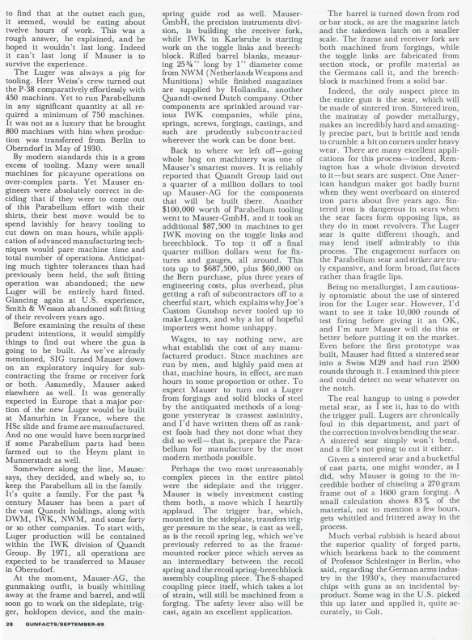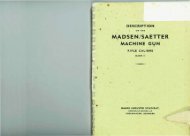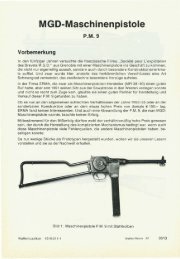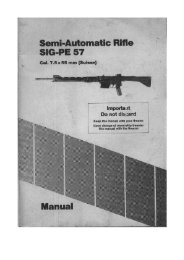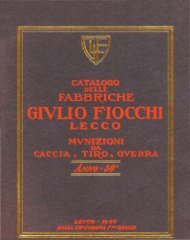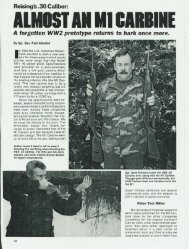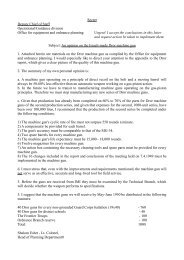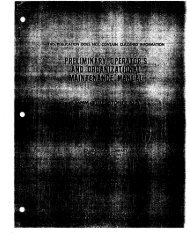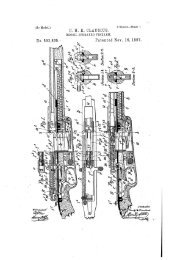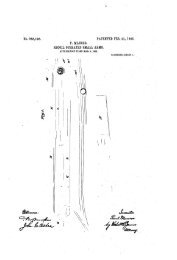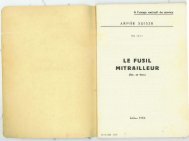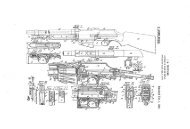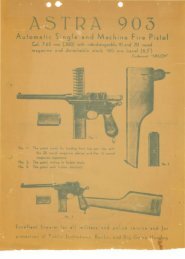The Parabellum Story (GunFacts).pdf - Forgotten Weapons
The Parabellum Story (GunFacts).pdf - Forgotten Weapons
The Parabellum Story (GunFacts).pdf - Forgotten Weapons
You also want an ePaper? Increase the reach of your titles
YUMPU automatically turns print PDFs into web optimized ePapers that Google loves.
to find that at the outset each gun,<br />
it seemed, would be eating about<br />
twelve hours of work. This was a<br />
rough answer, he explained, and he<br />
hoped it wouldn't last long. Indeed<br />
it can't last long if Mauser is to<br />
survive the experience.<br />
<strong>The</strong> Luger was always a pig for<br />
tooling. Herr Weiss's crew turned out<br />
the P-38 comparatively effortlessly with<br />
450 machines. Yet to run <strong>Parabellum</strong>s<br />
in any significant quantity at all required<br />
a minimu.m of 750 machines.<br />
It was not as a luxury that he brought<br />
800 machines with him when production<br />
was transferred from Berlin to<br />
Oberndorf in May of 1930.<br />
By modern standards this is a gross<br />
excess of tooling. Many were small<br />
machines for picayune operations on<br />
over-complex parts. Yet Mauser engineers<br />
were absolutely correct in deciding<br />
that if they were to come out<br />
of this <strong>Parabellum</strong> effort with their<br />
shirts, their best move would be to<br />
spend lavishly for heavy tooling to<br />
cut down on man hours, while application<br />
of advanced manufacturing techniques<br />
would pare machine time and<br />
total number of operations. Anticipating<br />
much tighter tolerances than had<br />
previously been held, the soft fitting<br />
operation was abandoned; the new<br />
Luger will be entirely hard fitted.<br />
Glancing again at U.S. experience,<br />
Smith & Wesson abandoned soft fitting<br />
of their revolvers years ago.<br />
Before examining the results of these<br />
prudent intentions, it would simplify<br />
things to find out where the gun is<br />
going to be built. As we've already<br />
mentioned, SIG turned Mauser down<br />
on an exploratory inquiry for subcontracting<br />
the frame or receiver fork<br />
or both. Assumedly, Mauser asked<br />
elsewhere as well. It was generally<br />
expected in Europe that a major portion<br />
of the new Luger would be built<br />
at Manurhin in France, where the<br />
HSc slide and frame are manufactured.<br />
And no one would have been surprised<br />
if some <strong>Parabellum</strong> parts had been<br />
farmed out to the Heym plant in<br />
Munnerstadt as well.<br />
Somewhere along the line, Mauser<br />
says, they decided, and wisely so, to<br />
keep the <strong>Parabellum</strong> all in the family<br />
It's quite a family. For the past 3/4<br />
century Mauser has been a part of<br />
the vast Quandt holdings, along with<br />
DWM, IWK, NWM, and some forty<br />
or so other companies. To start with,<br />
Luger production will be contained<br />
within the IWK division of Quandt<br />
Group. By 1971, all operations are<br />
expected to be transferred to Mauser<br />
in Oberndorf.<br />
At the moment, Mauser-AG, the<br />
gunmaking outfit, is busily whittling<br />
away at the frame and barrel, and will<br />
soon go to work on the sideplate, trigger,<br />
holdopen device, and the main-<br />
28 GUNFACT S / SEPT EMBER-89<br />
spring guide rod as well. Mauser<br />
GmbH, the precision instruments division,<br />
is building the · receiver fork,<br />
while IWK in Karlsruhe is starting<br />
work on the toggle links and breechblock.<br />
Rifled barrel blanks, measuring<br />
25 3 /4 ' ' long by 1'' diameter come<br />
from NWM (Netherlands <strong>Weapons</strong> and<br />
Munitions) while finished magazines<br />
are supplied by Hollandia, another<br />
Quandt-owned Dutch company. Other<br />
components are sprinkled around various<br />
IWK companies, while pins,<br />
springs, screws, forgings, castings, and<br />
such are prudently subcontracted<br />
wherever the work can be done best.<br />
Back to where we left off-going<br />
whole hog on machinery was one of<br />
Mauser's smartest moves. It is reliably<br />
reported that Quandt Group laid out<br />
a quarter of a million dollars to tool<br />
up Mauser-AG for the components<br />
that will be built there. Another<br />
$100,000 worth of <strong>Parabellum</strong> tooling<br />
went to Mauser-GmbH, and it took an<br />
additional $87,500 in machines to get<br />
IWK moving on the toggle links and<br />
breechblock. To top it off a final<br />
quarter million dollars went for fixtures<br />
and gauges, all around. This<br />
tots up to $687,500, plus $60,000 on<br />
the Bern purchase, plus three years of<br />
engineering costs, plus overhead, plus<br />
getting a raft of subcontractors off to a<br />
cheerful start, which explains why Joe' s<br />
Custom Gunshop never tooled up to<br />
make Lugers, and why a lot of hopeful<br />
importers went home unhappy.<br />
Wages, to say nothing new, are<br />
what establish the cost of any manufactured<br />
product. Since machines are<br />
run by men, and highly paid men at<br />
that, machine hours, in effect, are man<br />
hours in some proportion or other. To<br />
expect Mauser to turn out a Luger<br />
from forgings and solid blocks of steel<br />
by the antiquated methods of a longgone<br />
yesteryear is crassest assininity,<br />
and I'd have written them off as rankest<br />
fools had they not done what they<br />
did so well-that is, prepare the <strong>Parabellum</strong><br />
for manufacture by the most<br />
modern methods possible.<br />
Perhaps the two most unreasonably<br />
complex pieces in the entire pistol<br />
were the sideplate and the trigger.<br />
Mauser is wisely investment casting<br />
them both, a move which I heartily<br />
applaud. <strong>The</strong> trigger bar, which,<br />
mounted in the sideplate, transfers trigger<br />
pressure to the sear, is cast as well,<br />
as is the recoil spring leg, which we've<br />
previously referred to as the framemounted<br />
rocker piece which serves as<br />
an intermediary between the recoil<br />
spring and the recoil spring-breechblock<br />
assembly coupling piece. <strong>The</strong>S-shaped<br />
coupling piece itself, which takes a lot<br />
of strain, will still be machined from a<br />
forging. <strong>The</strong> safety lever also will be<br />
cast, again an excellent application.<br />
<strong>The</strong> barrel is turned down from rod<br />
or bar stock, as are the magazine latch<br />
and the takedown latch on a smaller<br />
scale. <strong>The</strong> frame and receiver fork are<br />
both machined from forgings, while<br />
the toggle links are fabricated from<br />
section stock, or profile material as<br />
the Germans call it, and the breechblock<br />
is machined from a solid bar.<br />
Indeed, the only suspect piece in<br />
the entire gun is the sear, which will<br />
be made of sintered iron. Sintered iron,<br />
the mainstay of powder metallurgy,<br />
makes an incredibly hard and amazingly<br />
precise part, but is brittle and tends<br />
to crumble a bit on corners under heavy<br />
wear. <strong>The</strong>re are many excellent applications<br />
for this process-indeed, Remington<br />
has a whole division devoted<br />
to it-but sears are suspect. One American<br />
handgun maker got badly burnt<br />
when they went overboard on sintered<br />
iron parts about five years ago. Sintered<br />
iron is dangerous in sears when<br />
the sear faces form opposing lips, as<br />
they do in most revolvers. <strong>The</strong> Luger<br />
sear is quite different though, and<br />
may lend itself admirably to this<br />
process. <strong>The</strong> engagement surfaces on<br />
the <strong>Parabellum</strong> sear and striker are truly<br />
expansive, and form broad, flat faces<br />
rather than fragile lips.<br />
Being no metallurgist, I am cautiously<br />
optomistic about the use of sintered<br />
iron for the Luger sear. However, I'd<br />
want to see it take 10,000 rounds of<br />
test firing before giving it an OK,<br />
and I'm sure Mauser will do this or<br />
better before putting it on the market.<br />
Even before the first prototype was<br />
built, Mauser had fitted a sintered sear<br />
into a Swiss M29 and had run 2500<br />
rounds through it. I examined this piece<br />
and could detect no wear whatever on<br />
the notch.<br />
<strong>The</strong> real hangup to using a powder<br />
metal sear, as I see it, has to do with<br />
the trigger pull. Lugers are chronically<br />
foul in this department, and part of<br />
the correction involves bending the sear.<br />
A sintered sear simply won' t bend,<br />
and a file's not going to cut it either.<br />
Given a sintered sear and a bucketful<br />
of cast parts, one might wonder, as I<br />
did, why Mauser is going to the incredible<br />
bother of chiseling a 270 gram<br />
frame out of a 1600 gram forging. A<br />
small calculation shows 83 % of the<br />
material, not to mention a few hours,<br />
gets whittled and frittered away in the<br />
process.<br />
Much verbal rubbish is heard about<br />
the superior quality of forged parts,<br />
which hearkens back to the comment<br />
of Professor Schlesinger in Berlin, who<br />
said, regarding the German arms industry<br />
in the 1930's, they manufactured<br />
chips with guns as an incidental byproduct.<br />
Some wag in the U.S. picked<br />
this up later and applied it, quite accurately,<br />
to Colt.


